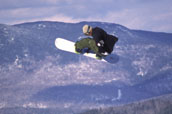Snowboarding: History of Snowboarding
Snowboarding: Born In New England – The Birth of a New Sport
 Take a passion for surfing, skateboarding, and skiing, mix it with the force of gravity, bring it to the mountains and Voila! You have the birth of snowboarding. In the 1960’s and 70’s, early ‘boarders called themselves ‘Snurfers” (Snow + Surfer) and would hurl themselves down mountains with no foot straps and no control, on boards that were little more than two skis strapped together. Much like the antiquated surfboards of the 1960’s, the first snurf boards were unreasonably long and cumbersome.In the early 1970’s, not only did the size of surfboards decrease to a more modern and manageable size, the snurf boards did as well. It was at this point that Jake Burton Carpenter began developing safe and manageable snowboards in earnest. Working out of his garage in Manchester, VT, Burton had a vision of bringing snowboarding to the world. In the mid-70’s he began shaping snowboards out of wood and attaching rubber foot straps to them as primitive bindings. This vision apparently succeeded, because Burton Snowboards has been one of the leading forerunners in the snowboard industry for the last 30 years. The vision of Jake Burton in the 1970’s has directly influenced today’s modern sport of snowboarding.In the late 1970’s and early 1980’s, Vermont was home to the first established snowboard competition in the world – the National Races at Suicide Six in Pomfret, VT. A concentrated interest in this sport eventually spawned the US Open, the world’s first renowned snowboard competition. Originally held at Magic Mountain, the US Open eventually moved to Stratton Mountain Resort (VT), for a couple of seasons.
Take a passion for surfing, skateboarding, and skiing, mix it with the force of gravity, bring it to the mountains and Voila! You have the birth of snowboarding. In the 1960’s and 70’s, early ‘boarders called themselves ‘Snurfers” (Snow + Surfer) and would hurl themselves down mountains with no foot straps and no control, on boards that were little more than two skis strapped together. Much like the antiquated surfboards of the 1960’s, the first snurf boards were unreasonably long and cumbersome.In the early 1970’s, not only did the size of surfboards decrease to a more modern and manageable size, the snurf boards did as well. It was at this point that Jake Burton Carpenter began developing safe and manageable snowboards in earnest. Working out of his garage in Manchester, VT, Burton had a vision of bringing snowboarding to the world. In the mid-70’s he began shaping snowboards out of wood and attaching rubber foot straps to them as primitive bindings. This vision apparently succeeded, because Burton Snowboards has been one of the leading forerunners in the snowboard industry for the last 30 years. The vision of Jake Burton in the 1970’s has directly influenced today’s modern sport of snowboarding.In the late 1970’s and early 1980’s, Vermont was home to the first established snowboard competition in the world – the National Races at Suicide Six in Pomfret, VT. A concentrated interest in this sport eventually spawned the US Open, the world’s first renowned snowboard competition. Originally held at Magic Mountain, the US Open eventually moved to Stratton Mountain Resort (VT), for a couple of seasons.
Vermont was also the first state in America to offer terrain parks at its ski resorts. In the early 1980’s, the tiny Sonnenburg Ski Hill near Barnard, VT was one of the first to open its arms to snowboarders. Not only did Sonnenburg give those early snowboarders free reign to build their own jumps on one trail, they also provided an endless supply of hay bales and picnic tables for jumping as well. Because the vast majority of ski resorts would not allow snowboarding on their trails at the time, what Sonnenburg did was truly groundbreaking. Due to Sonnenburg’s willingness to open their doors to snowboarders, terrain parks are now a common-place sight at most American ski resorts and countless other international resorts as well.
Thanks to the innovative visions of a handful of Vermonters, snowboarding is now an internationally accepted sport worldwide. In 1988, the US Amateur Snowboarder Association was formed. By 1990, it had grown to become the International Snowboarding Federation. Finally, in 1998, snowboarding made it big. People started realizing it wasn’t a fad that would fade as quickly as it seemed to have appeared. No longer considered just an ‘extreme’ sport, snowboarding had at last become a recognized Olympic sport. Vermont was well represented at the Olympics in Nagano, Japan that year, with several native Vermonters competing in two different competitions: the Half-pipe and the Giant Slalom.
Today, Maine ski areas and Maine Winter Resorts continually improve their snowboarding services, with newer and more innovative terrain opening each season.
History of Snowboarding | Learning to Snowboard | Snowboarding Terminology | ME Snowboarding & Ski Resorts
Did we miss something?
Add your update or comment.
Pet Friendly Lodging | Personals
Maine Weddings | Visit Maine Town Guides
New England Living Magazine |








